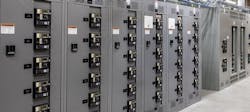Cummins opens new Microgrid testing lab in Minnesota
Power generator and equipment firm Cummins has opened an expansive new microgrid lab to test integration of traditional gen-sets with renewable technologies.
The Cummins Power Integration Center will be in Fridley, Minnesota. The PIC will facilitate the integration and testing of power system technologies across the resource spectrum, including diesel and natural gas generator sets, photovoltaic solar panels, battery storage systems, fuel cells, transfer switches, switchgear, and system-level controls.
“The PIC is the realization of a significant investment in engineering technology and innovation that will impact how companies use and build power systems to meet sustainability goals for a greener future,” said Gary Johansen, Cummins Vice President – Power Systems Engineering and Project Sponsor. “Our customers are placing an even higher value on flexible and well-integrated solutions and this center will help us speed up the time it takes to deliver those new solutions.”
The 20,000 square foot facility will include an outdoor test area, engineering control room, main switchgear room and electrical mezzanine. A wide variety of microgrid configurations can be tried and tested, with additional distributed resource such as energy storage, generator sets, fuel cells and inverters brought in for the testing.
The outdoor area of the PIC has five 500-kW test pads and two 2000-kW (2 MW) test pads, which can be connected. It has two 500-kW programmable load banks to run scenarios using real customer load profile data, at up to 0.8 leading or lagging power factor.
The different lab assets are connected with three indoor switchgear lineups and eventually connect to the site utility connection. A 500-kW permanently installed roof-mounted PV system is also connected to the lab as well as PV and energy storage simulators for testing inverters.
The engineering control room has workstations for technicians to access the different elements of the microgrid system being tested and work with customers and technical partners.
Cummins is growing its stake in a wide variety of C&I Energy Transition and decarbonization movements. The company is doing work with partners around hydrogen, electric vehicles and microgrids.
Earlier this month, Cummins announced it was investing $24 million in redox flow-based energy storage firm VoltStorage.
The historic generator maker also has contributed to microgrid project such as Calvert island in Canada, the Agnew gold mine in Australia and Fisherman’s Landing in Canada, among others.
About the Author
EnergyTech Staff
Rod Walton is senior editor for EnergyTech.com. He has spent 17 years covering the energy industry as a newspaper and trade journalist.
Walton formerly was energy writer and business editor at the Tulsa World. Later, he spent six years covering the electricity power sector for Pennwell and Clarion Events. He joined Endeavor and EnergyTech in November 2021.
He can be reached at [email protected].
EnergyTech is focused on the mission critical and large-scale energy users and their sustainability and resiliency goals. These include the commercial and industrial sectors, as well as the military, universities, data centers and microgrids.
Many large-scale energy users such as Fortune 500 companies, and mission-critical users such as military bases, universities, healthcare facilities, public safety and data centers, shifting their energy priorities to reach net-zero carbon goals within the coming decades. These include plans for renewable energy power purchase agreements, but also on-site resiliency projects such as microgrids, combined heat and power, rooftop solar, energy storage, digitalization and building efficiency upgrades.
